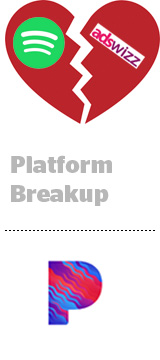
Spotify has terminated its relationship with AdsWizz since Pandora acquired the programmatic audio platform for $145 million in March.
Spotify confirmed the news Tuesday, shortly after Pandora’s second quarter earnings call.
“We did sunset our partnership with AdsWizz,” said Spotify in an emailed statement to AdExchanger. “That being said, we remain dedicated to offering advertisers automated solutions to access our engaged audience and quality inventory, which continues to be available in the programmatic ecosystem through Rubicon Project and AppNexus as well our self-service ad platform, Spotify Ad Studio.”
Spotify, which launched programmatic audio capabilities in 2016, has developed a private marketplace that integrates with DSPs including MediaMath and The Trade Desk, as well as a self-serve platform.
Without Spotify, Pandora loses access to an audience of 101 million monthly ad supported listeners, as well as a large chunk of supply in international markets.
Pandora CEO Roger Lynch, however, seemed unfazed by Spotify’s departure and said on the company’s Q2 call that the “vast, vast majority” of publishers have remained on the AdsWizz platform.
“When we acquired AdsWizz, our assumption was that they would lose some publishers, especially ones that might view us as competitive,” Lynch said. “The results so far have been much more positive than our expectations. We think that will likely continue because … we now represent the vast majority of all audio inventory available programmatically.”
Programmatic: Press play
Pandora’s earnings call was the platform’s first since acquiring AdsWizz in March, and it occurred just hours after the platform announced that its programmatic audio inventory is available generally to buyers.
“Our approach will be deliberate, with a gradual increase in the amount of inventory sold through audio programmatic,” Lynch said. “Over time, we expect this to fundamentally increase demand for digital audio.”
Revenues at Pandora grew 12% year over year to $385 million. Advertising revenues were $271 million, up from $215 million in Q1. Subscription revenues were up 67% to $114 million.
Despite being slow to launch programmatic audio compared to its peers, Pandora has quickly turned around an offering after announcing its intention to launch the capability in late 2017. So far, brands including P&G, Coca Cola and Sony have seen positive test results.
“It enables us … to recapture portions of the budget that we have lost access to by not having programmatic,” Lynch said, “and I’m sure there may be other advertisers that only want to buy programmatically that we will be able to attract.”
Pandora is building a self-serve product to scale access to its programmatic inventory to smaller buyers, but it didn’t share a release date.
“Small buyers are largely out of reach today because of the cost of our IO process,” Lynch said.
Lynch assured advertisers that, unlike other digital platforms like Snapchat, Pandora will not see CPMs plummet in the shift to programmatic because it controls the majority of digital audio inventory available in the market.
“We’ll be judicious in how much inventory we make available, to make sure it doesn’t have a deflationary impact,” Lynch said. “Our expectations are probably neutral to even positive.”
Bring back the listeners
Despite positive revenue growth, Pandora’ monthly active users are still declining, from 72.3 million in Q1 to in 71.4 million in Q2. The company plans to invest an additional $10 million in a marketing blitz to gain back users, with “almost all of our budget directed toward highly targeted performance marketing,” Lynch said.
“We used our data really well for our product and advertisers, but not nearly as well in our own marketing,” he said. “We think there is significant opportunity to grow the size and engagement of our audience with increased spend in targeted marketing and enhanced CRM.”
Pandora also hopes to gain back listeners through partnerships with other tech providers. The platform recently partnered with AT&T and T-Mobile on a bundled subscription for premium data subscribers. It also has an integration with Snap that allows users to share what they’re listening to with friends.
“We think the Snap partnership will increase our engagement with younger users,” Lynch said.
And as for podcasts, which Pandora is pushing to add to its platform, the focus is to enable personalization and monetization, he said. “We think it will be instrumental in us going after the terrestrial radio market.”
This post was syndicated from Ad Exchanger.


More Stories
Publicis Media Exchange ANZ appoints Anthony Ellis as CEO
Creator Jayde Powell Has the Tea on Finding a Safe Space in Social Media
Sex.life’s quickie to 1 million downloads